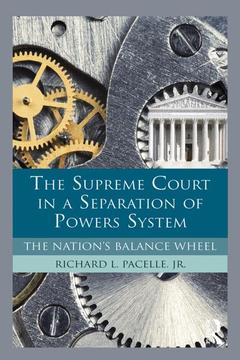The Supreme Court in a Separation of Powers System The Nation's Balance Wheel
Auteur : Pacelle Richard

The U.S. Supreme Court is not a unitary actor and it does not function in a vacuum. It is part of an integrated political system in which its decisions and doctrine must be viewed in a broader context. In some areas, the Court is the lead policy maker. In other areas, the Court fills in the gaps of policy created in the legislative and executive branches. In either instance, the Supreme Court?s work is influenced by and in turn influences all three branches of the federal government as well as the interests and opinions of the American people.
Pacelle analyzes the Court?s interaction in the separation of powers system, detailing its relationship to the presidency, Congress, the bureaucracy, public opinion, interest groups, and the vast system of lower courts. The niche the Court occupies and the role it plays in American government reflect aspects of both the legal and political models. The Court has legal duties and obligations as well as some freedom to exercise its collective political will. Too often those studying the Court have examined it in isolation, but this book urges scholars and students alike to think more broadly and situate the highest court as the "balance wheel" in the American system.
Selected Contents: Introduction. Recalculating: Getting to the Supreme Court with a GPS 1. The Supreme Court: The Nation’s Balance Wheel? 2. The Supreme Court and the President: An "Informal and Limited Alliance" 3. The Supreme Court and Congress: The First Shall be Last, Will the Last be First? 4. The Supreme Court and the Bureaucracy: The Clash of Kafkaesque Forces? 5. Public Opinion: The Two Faces of Janus 6. "Lobbying" the Judicial Branch: May it Please the Court? 7. The Supreme Court and the Lower Courts: A Bureaucracy to Call Your Own 8. Conclusion
Richard L. Pacelle, Jr., is Professor and Head of the Department of Political Science at the University of Tennesse. His research focuses on the U.S. Supreme Court and he is the recipient of numerous awards for both teaching and scholarship.
Date de parution : 02-2015
15.2x22.9 cm
Date de parution : 01-2015
Ouvrage de 208 p.
15.2x22.9 cm
Thème de The Supreme Court in a Separation of Powers System :
Mots-clés :
sincere; policy; preferences; lower; courts; attitudinal; model; decision-making; models; stare; Sincere Policy Preferences; Pe Rc; Supreme Court; Solicitor General; Law Reviews; Modern Supreme Court; Preferred Position Doctrine; Attitudinal Model; Circuit Courts; Sincere Preferences; En Banc; Lower Court Judges; Brown II; Amicus Curiae; Dangerous Branch; Vice Versa; Court’s Legitimacy; Diffuse Support; Organized Litigants; RP; Statutory Cases; Amicus Briefs; Young Man; Supreme Court Precedent; Lower Court



